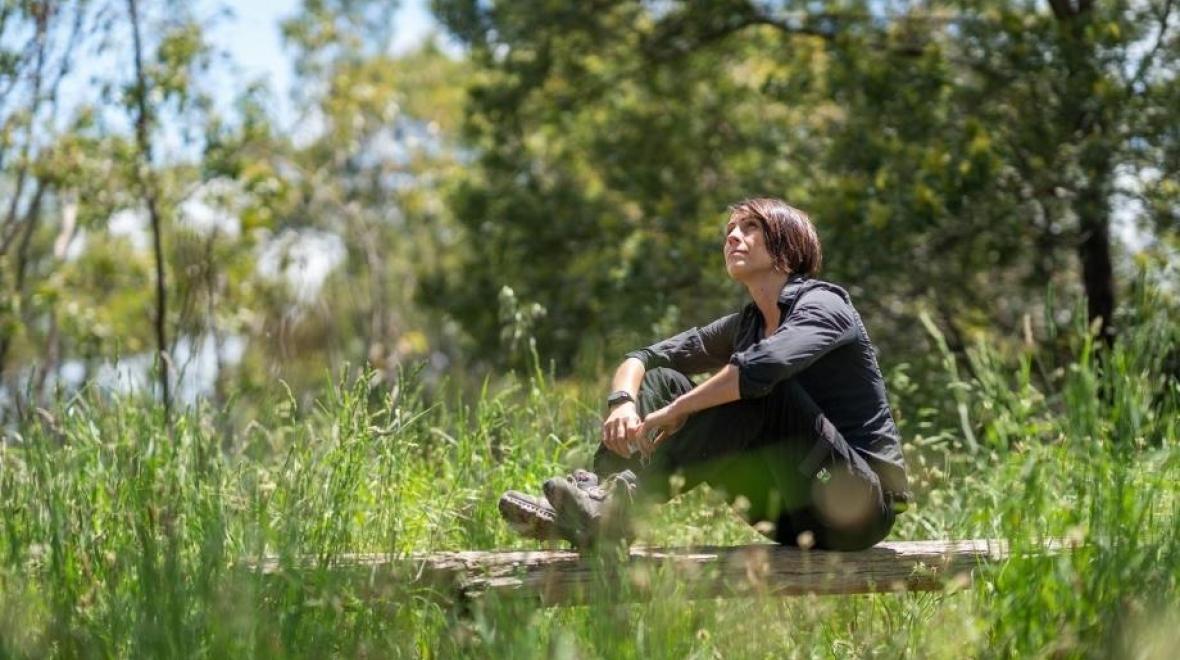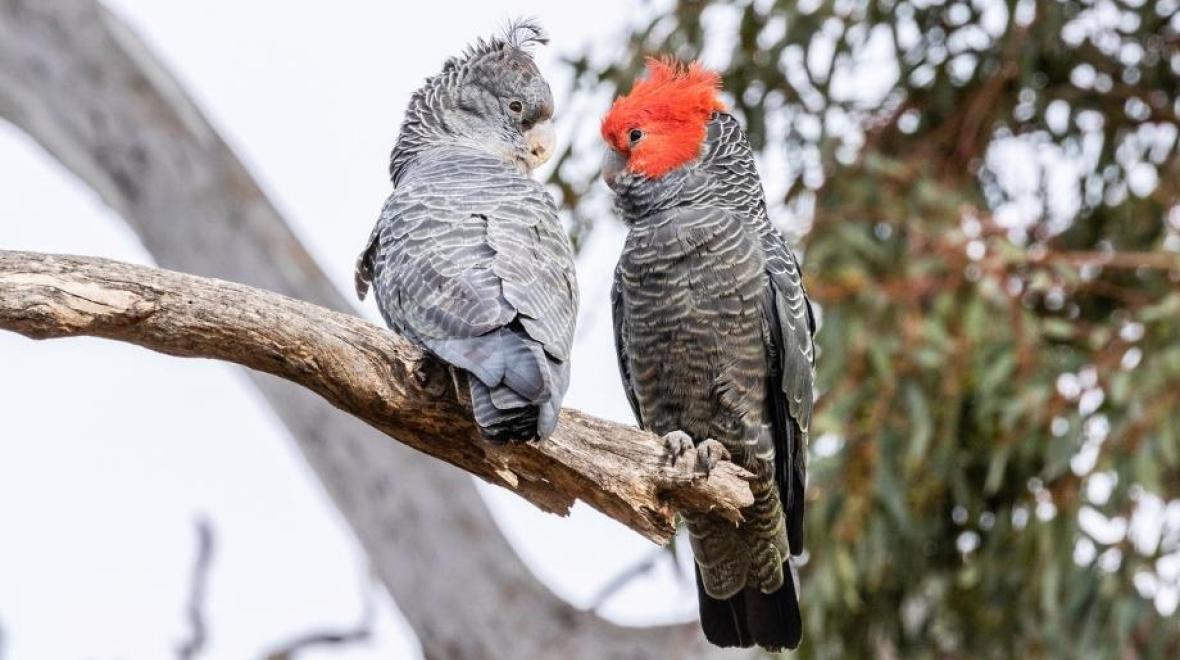Get to know the gang-gang cockatoo
Their most distinctive trait is their call that is often heard while they are in flight. Many compare their call to the sound of a drawn-out creaky door.
They are the faunal emblem of the Australian Capital Territory, but enthusiasm for the gang-gang cockatoo stretches far beyond the Canberra bubble.
That became clear in the 2021 Bird of the Year poll, where they finished third out of 50 Australian native birds.
Despite their popularity, we don't know a lot about them. No formal research or monitoring has been conducted about the species, says Stacey Taylor, a Master's student at The Australian National University (ANU) who is studying the patterns of occupancy of the gang-gang across the ACT.
We asked our gang-gang guru what we know about the birds, what we still need to find out, and what makes these charismatic cockies special.
Gang-gangs are a pretty parrot
Gang-gangs, one of 14 cockatoo species in Australia, are crowd favourites for their slate-grey feathers with blushes of pink, the male's distinctive red crest, and their quirky call.
"Gang-gangs are an incredibly beautiful parrot," Taylor says. "The males boast a spectacular red head and both the males and females have a wispy crest."
"They are not as commonly spotted as other similar sized parrots and should certainly not be mistaken for the much more common, but also beautifully coloured, galah."
If you can't get close enough to identify it, try listening instead. "Their most distinctive trait is their call that is often heard while they are in flight. Many compare their call to the sound of a drawn-out creaky door."
They are a Canberra icon
When the Australian Capital Territory adopted the gang-gang as its emblem in 1997 it was the only state or territory to feature a bird as its faunal emblem instead of a mammal. (The Southern brush-tailed rock-wallaby was chosen as the ACT's mammal emblem in 2018.) The gang-gang is also the insignia for the ACT Parks and Conservation Service and the Canberra Ornithologist Group - our local bird loving group.
"Some gang-gangs move to lower elevations in winter but some remain in areas with higher elevation," Taylor says.
While they hold a special spot in the heart of Canberrans, you'll also find gang-gangs well beyond the territory.
"Gang-gangs are endemic to eastern Australia. They occur along the Great Dividing Range from the central north coast of NSW, through the ACT and central and southwestern Victoria, to the South Australian border," Taylor says.
Until the 1960s, their habitat even stretched as far south as King Island, off Tasmania's northwest coast. They were one of several mainland birds introduced to Kangaroo Island in South Australia between 1911 and 1957 when part of Flinders Chase was identified as a sanctuary due to its lack of pests.
"Gang-gangs are a canopy specialist and occur primarily in forest and woodland habitats," Taylor says.
Gang-gangs are small but powerful
Despite being Australia's smallest black cockatoo, gang-gangs have notoriously powerful beaks.
"They use their beaks to strip bark off trees to line hollows in preparation for egg incubation," Taylor says. "Instead of leaves, feathers or other material, gang-gang's make a cosy bed of chewed bark for their eggs."
Their hollow requirements are similar to other parrots and wood ducks. "Wood ducks are early season breeders and gang-gangs are known to use the same hollow in the same year, once wood ducks have fledged."
They are also noisy eaters.
"You can often hear the sound of falling debris where they are enthusiastically chewing fruits in the canopy," Taylor says. "It may be a surprise to many that gang-gangs are not strict herbivores. While they regularly eat the seeds and fruits of eucalypts and acacias and many types of introduced garden species, they also enjoy sawfly larvae and will even eat cicadas and acacia galls."
Gang-gangs are under threat
Reporting rates of gang-gangs have been in decline across much of their range, but it's not entirely known why. "They were listed as vulnerable in NSW in 2005 following dramatic population declines," Taylor says. "These declines are likely to have been exacerbated by the 2019-2020 bushfires, which burnt approximately 18 per cent of their range."
In March 2022, the gang-gang was officially listed as an endangered species, following a recommendation from the Threatened Species Scientific Committee, which noted the bird's population had declined by approximately 69 per cent in the last three generations.
"Due to the lack of dedicated research and monitoring, the reasons for these declines are not well understood," Taylor says.
Primary threats are likely to include the loss of habitat, including the loss of nesting hollows, the effects of climate change, including the impacts of heat stress on young birds, and severe fire events. "Wildfires can destroy nest trees and can suppress seed production of their key feed species."
There's still a lot to learn
They might be popular, but gang-gangs are the least studied species in their family. "While the gang-gang is an incredibly iconic bird in the ACT, little is understood about its local ecology," Taylor says. "We have citizen science to thank for much of the information we know about gang-gang ecology in the ACT.
"Citizen scientists have collected information on their breeding behaviour and location of breeding hollows across Canberra's urban areas."
Now the Difficult Bird Research Group (DBRG) is on the case.
"The DBRG studies Australia's most endangered birds in the hope to learn more about them to inform conservation," Taylor says. "The gang-gang is no exception."
"It is critical that we begin to fill some fundamental knowledge gaps about this species in order to help improve their conservation status."
Taylor is leading a small team to undertake systematic surveys of gang-gangs across the ACT as part of a collaborative project between ANU and the ACT Government.
"The project aims to better understand the distribution and abundance of gang-gangs within the ACT and to identify areas critical for foraging and breeding," she says. "Better understanding the detectability and ecology of the bird is critical to develop an ongoing monitoring protocol that can be applied in the ACT and other areas across its distribution."
During spring, the team spent many hours searching for gang-gangs across Canberra's urban open spaces and Canberra Nature Park. Unfortunately, the team detected much fewer birds than anticipated.
"The data has not yet been analysed but we were surprised how few gang-gangs we encountered," Taylor says.
"The preliminary results highlight the importance of employing systematic surveys to accurately estimate the population size of rare and threatened species in the landscape. This is critical to monitor changes in their abundance and conservation status over time."
This article was originally published in December 2021 and has been updated to reflect the gang-gang's inclusion on the threatened species list in March 2022.





